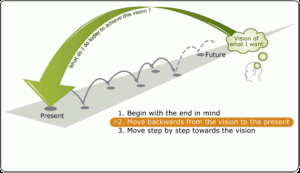Using the Community Food Toolkit
i. Getting Started ii. Visioning Exercises iii. SWOT Analysis and Asset / Gap Mapping
iv. Case Studies
To move forward, you need to know where you want to go. So the next step is to determine a vision with respect to your community long-term food goals. There are many different strategies in approaching the visioning process, but we will share the one from the Natural Step as it is the most familiar to us and provides a lot of support resources.
This approach is called ‘backcasting’ and involves imagining the future you want and then figuring out how to work towards it (Figure 1). The benefit of this approach is your group will tend to be less constrained by current pressures and be more able to envision the future you want (for more information refer to the Natural Step, Backcasting.
Figure 1: Backcasting (Source: The Natural Step)
The backcasting exercise (to help envision where you want to go)
One way to begin this process is to divide your large group into sub-groups of 4-6 people and ask them to answer a series of questions or fill thoughts in to complete sentences. For example:
* What kind of food would you like the people in your community to have access to in twenty years? Describe what that system would look like. Where does the food come from? What kind of food is it? How much does it cost? Who has access to it? How is it produced?
* My ideal food system includes __________________________
Each person within the sub-groups can answer the questions and you can then discuss and compile your answers or the group can develop a list together.
Or you can use a World Cafe set-up (for more information on this approach you can go to: http://www.theworldcafe.com/pdfs/cafetogo.pdf). Using this approach you ask people who want to, to write an idea about their ideal food community on a large piece of paper at the front of the room. Once you have several ideas on offer, ask those people to lead a discussion group about that idea and ask people to join whichever group most interests them. Also, encourage people to move from group to group and to share ideas.
Whether you use the sub-group approach or the World Cafe approach, after a set amount of time for discussion – usually anywhere from 20 minutes to one hour — each smaller group needs to put their list in order of most to least important ideas. Once you have lists developed in each of the smaller groups, you are ready to gather your ideas together into a cohesive set. Ask each group to share their top answers with the entire group. You will need someone writing down these points. Flip charts are usually good tools to use for this type of exercise.
When you have a list of ideas that are posted for everyone to see you can figure out which ideas have the most traction…
* ask for a show of hands
* have people vote on the ideas they think are the most important. Giving everyone a set number of sticky dots and letting them place their dots on the ideas of their choice can be effective.
* group ideas together and ask people to express support
* develop a consensus by having a discussion
The goal is to develop a vision that expresses where your community food system aspirations. Some sample visions are:
From the Ottawa Food Action Planning process:
We envision…
A city where all people have access not only to healthy and affordable food, but also access to knowledge, information, and opportunities to learn about food, nutrition, agriculture, and food systems. A city that supports partnerships and linkages between emergency food relief services, food security programs, and a broad spectrum of community-based and city-run food programs and services.
From the Durham Food Charter,
“Planning Food Into Our Future”
The Durham Region Food Charter reflects the community’s vision for a food secure Durham Region focused toward building a just and sustainable local food system as a foundation for population health. Based on community participation a sustainable local food system will improve the economic viability of Durham Region’s food industry, work in harmony with natural heritage systems as well as the built environment, and promote overall health…A food secure Durham Region is financially sound, environmentally responsible and socially just, contributing to the future well being of our region and its residents.
These are some suggestions about how to get your process started. Every community is different so you will find what works for you by getting started and as you work through the process.


